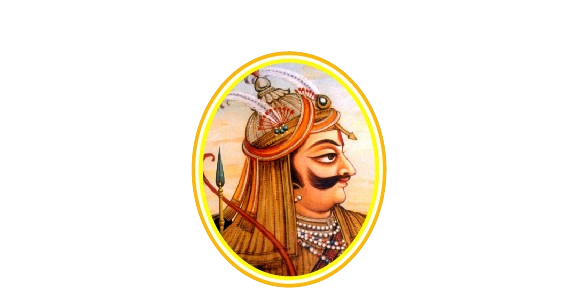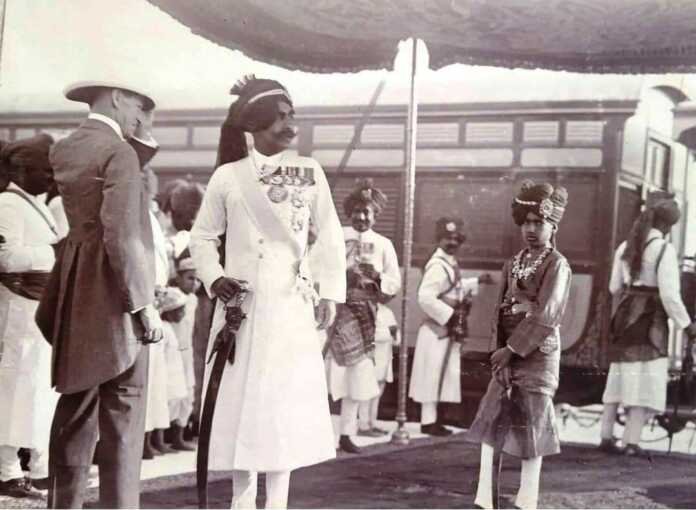Legislative Assembly Of Bikaner State was established in 1913 A.D. It was first princely state which established an elected legislative assembly in princely states of India.
The people of princely states of India had to struggle hard for civil rights and liberties, responsible government and for the establishment of an independent judiciary and the separation of judicial and executive functions.
Princely state of Bikaner was founded by Rao Bika Rathore in 1465A.D. As in other states the system of government in Bikaner was originally unalloyed despotism. The seeds of representative government were first sown in 1908 by non-officials being invited to the administrative conference. In 1912, Maharaja Ganga Singh announced his intention of instituting a Representative assembly which was sub-sequently designated as the Legislative assembly.[1] Thus he won the credit of being the first ruler in Rajasthan to establish an elected legislative assembly in his state.
The constitution of the Council was drafted jointly by the His Highness and the Hon’ble Sir William Vincent. The council was to represent all classes and gradually the privilege of election was to be extended to municipalities and Jagirdars.
The assembly, the composition of which approved by the Maharajah was to have 35 members with the statutory maximum number of 40.[2]
The members were divided in three categories-
(1) Members of the Maharaja’s executive council,
(2) Elected members and
(3) Nominated members.
Their ratio was 6:10:19 respectively. As regards the elected and nominated members the provision made for the same was as under-
1. Three persons were to be elected from amongst the Tazimi Sardars, two were from the Bikaner municipality, two from the Churu municipality and one from each of the municipalities of Sardarshahr, Ratangarh Surajgarh and Lahore.
2. Nominated- The Maharaja nominated two amongst the Rajvis, three from the Tazimi Sardars, two from the Suratgarh Nizamat and one each from and amongst the residents of Bikaner and Sujangarh and one from the municipality of Bikaner. Besides these ten more members were nominated to this assembly.
It took three years for the legislative council to take practical shape. During this period the functions of the assembly were carried on by the nominated members. The assembly was inaugurated at 10-30A.M. on 10th November 1913.[3]
The members took the oath of allegiance to His Highness and, in accordance with the Indian customs, presented him their Nazars.[4] The function ended by receiving the blessings from the Raj Pandits.
The number of the members of the Representative assembly could vary and its nature was dynamic. In less than four years after its inauguration the Maharaja felt the necessity of enlarging its membership. In September 1917 its name was changed into Legislative assembly, [5] giving better impression of its functions.
Representation in the Legislative assembly was to be granted to all Municipalities with a population of over 2500 to send their elected members to it.[6] Later a Jat and a Sikh representatives of the Agricultural community were also nominated to the assembly. It helped in knowing the public opinion about the administration.
On the occasion of his birthday in October 1921,[7] the Maharaja formed a new board known As Zamindar’s Advisory Board. It had the right to send three members to the Legislative assembly to safeguard the interests of the Zamindars.
In addition the two nominated seats to which the headman of the Jat and Sikh communities had been usually appointed, were also reserved for agriculturists. Thus the number of elected members was raised to twenty, within eight years, i. e. double of what it was at the time of the formation of the assembly.[8]
By 1929 another Zamindar’s Board was instituted.[9] Besides, a ‘Local District Board’ was established at Ganganagar. This necessitated the reshuffling of the right of representation in the assembly. It was laid down that each of these two Zamindar’s Board were to send one representative to the Legislative assembly, while the Local District Board was empowered to send three representatives. The agricultural classes thus came to have five elected and two nominated members for safeguarding the interests of their community.[10]
The assembly was formed on the lines of the Imperial Legislative Council and members had the right to ask questions from the very beginning.[11]
Ordinarily, the assembly consisted of (a) the executive members of the government who were ex-officio members and (b) twenty nine other members of whom (i) ten were elected and (ii) nineteen nominated. But His Highness enjoyed the power to nominate two more persons[12] to the assembly. They could be from amongst officials or non-officials possessing expert knowledge of subjects connected with the proposed or pending legislation in the assembly. The number of elected members was 15.[13]
As regards nominations the Maharajah would nominate eleven members out of nineteen from the different categories in the following order :-
| From the Rajvis. | 2 members |
| From the Tazimi Sardars of the State. | 3 members |
| From the residents of the Nizamat Suratgarh | 2 members |
| From the residents of Bikaner. | 1 member |
| From the residents of Reni. | 1 member |
| From the residents of Sujangarh. | 1 member |
| From the Municipality of Bikaner. | 1 member |
If no suitable person could be available for selection from one class then another person could be nominated by the Maharajah to fill the vacancy. But every member, whether elected or nominated, had to take an oath of allegiance and faithfulness to the Maharajah.
No person could be eligible for election, if he possessed the following disqualifications; [14]
If one was not a subject of His Highness or was an official or was a female or was of unsound mind or was below 25 years of age or was a certified bankrupt or was a dismissed person from the service of the Maharajah or had undergone a sentence for more than six months or had been debarred from practicing as a legal practioner in the Bikaner State.
The franchise qualifications were also specifically mentioned. If a member after being elected became a victim to disqualifications or failed to take the oath within the prescribed time, the Maharajah by the notification in Bikaner Raj Patra could declare his election or nomination to be void and his seat to be vacant.[15]
In order to fill these vacancies it was provided that if a vacancy was to occur in case of nominated or elected member the Maharajah would, in the case of a nominated member, nominate a person against that vacancy, or in the case ofAn elected member, c all upon the electorate concerned to elect a person within the time As prescribed by the notification, or in case of a member representing a particular class would nominate another person
from the same class. [16]
Normally all the powers of making laws and regulations were vested in the meeting of the assembly at which atleast twelve or more members were present: But the final decision regarding the question of intention, construction or application of these regulations was that of the Maharaja himself. [17]
At the earlier stages no necessity was felt for the provision of a Vice President of the assembly. In May 1945A Vice-President was to be elected by the members from amongst themselves. More than three persons were not allowed to st and for election. The candidate who got the highest number of votes was elected.
The Bikaner Legislative assembly laid the foundation ofA representative government and paved the way for the realisation of the dream of responsible government. The State was still a ‘hot house of imprisonment and police zulooms ![18] The imposition of bans on political activities, imprisoning political leaders and the check on the civil liberties were still in vogue.[19] Besides the voracious character of the Bikaner bureaucracy, special privileges of the Rajvis and of the Tazimi Sardars stood in the way of social equality. Economically too, it continued to be backward.[20] Only four percent of the people were literate. Constitutionally there was no equality before law. The Legislative assembly was a body of popularly elected representatives in name only. The members did not enjoy real freedom of speech even inside the assembly. Throughout the period of twenty-three years only one question was disallowed on the ground of its being inconsistent with the public interest. Since the inauguration of the assembly, seventy-one resolutions were moved, out of which twenty-six were loyalty or courtesy resolutions. Of the remaining forty-five only seven were not accepted; nine were withdrawn by the movers; and three were discussed and lost. Only one resolution was disallowed for not being of general interest, but was of petty administrative routine. [21] might have been the drawbacks, one cannot but appreciate the fact that Bikaner was the first in Rajasthan to establish a popular Legislative assembly in the State
REFERENCES
[1] Four decades of progress in Bikaner, Printed at the Govt. Press, Bikaner in 1937, p. 69.
[2] B. Chronicler, Simla News paper, November 6, 1913.
[3] The inauguration Bikaner Legislative Council, vide News paper, Simla, dated 10th November, 1913.
[4] Draft notes on the assembly Scheme, File No.A-17, Legislative Department, p. 127.
[5] Proceedings of the Bikaner Legislative assembly, August, 1942, p. 19.
[6] Ibid.
[7] Ibid.
[8] Satya Bhanu Srivastav, Legislative assembly OF Bikaner, Rajasthan History Congress, pp. 194-199.
[9] Proceedings of the Bikaner Legislative assembly, August 1942, p. 19.
[10] Ibid.
[11] Ibid.
[12] Regulations for the nomination and election of additional members of the Bikaner assembly, p. 1
[13] Ibid. The order of the representation of the 15 members was As follows:
1. By the Tazimi Sardars of the Blkaner State
2. By the Municipality of Bikaner.
3. By the Municipality of Churu.
4. By the Municipality of Sardarshahr.
5. By the Municipality of Ratangarh.
6. By the Municipality of Sujangarh.
7. By the Municipality of Rajgarh or Nohar. (Alternately),
8. By the Municipality of Nohar.
9. By the Municipality of Reni.
10. By the Municipality of Bhadra.
11. By the Municipality of Dungargarh.
12. By the Municipality of Suratgarh and Hanumangarh jointly.
[14] Regulations for the nominations and election of additional members of Bikaner assembly, p. 8.
[15] Circumstances which the seat of a member was considered vacant were: (a) If a member tendered his resignation which was accepted, (b) If any member of the assembly accepted any office of profit under the Bikaner Government, (c) If a member was absent from the State of Bikaner, or was unable to attend the meeting of the assembly for three consecutive sessions.-Regulations for the nominations and election of additional members of Bikaner assembly, p. 8.
[16] Ibid.
[17] Ibid.
[18] Damodar Prasad Singhal, Dreamland of Responsible Government in Bikaner, published on 1st July 1946, Alwar, p. 4
[19] Ibid., pp. 4-5.
[20] Ibid., p. 5.
[21] Four decades of progress in Bikaner, p. 74.




